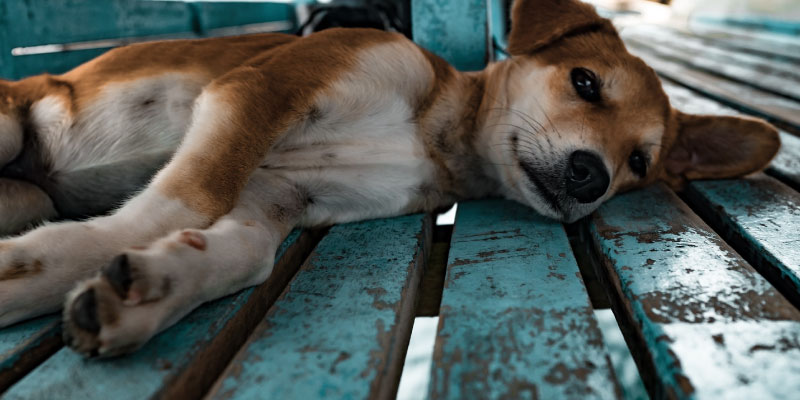It may not cross your mind to have a dog first aid kit in the house, but you almost certainly should. There’s no doggy paramedics or ambulances - their first point of emergency and contact before getting to the Vet is you.
The idea of plasters and skin creams seem normal for humans, but people often don’t think about their pup. That’s why you have Vets and such, right?

For many reasons, it’s essential to have a dog emergency kit in the home or if you are travelling, hiking or camping with your dog. Consider:
- Your dog may exhibit symptoms outside of normal vet hours/you may not be able to access an emergency vet
- Household accidents can happen, whether it’s a broken glass on ingesting the wrong food
- Younger dogs may be more susceptible to accidents
- Older dogs may be more susceptible to chronic pain
- You may not be able to get to your vet as easily – whether because of distance or means
While you shouldn’t be expected to have a whole operating table in your home, you can certainly put your mind at ease with some canine first aid kit essentials.
What to put in dog first aid kits
Many of these items are easily available from your local supermarket or online stores, but if you’re not sure, always ask your vet.
1. Medications
If your dog has any prescribed medications, or indeed any over the counter medicines like pills for stomach upsets, you should always keep a good supply of these. Ask your veterinarian if you can have a backup supply, particularly if you’re planning on going away.
Your medications should always be kept alongside any medical records. These records should show details of your dog’s latest vaccinations as well as historical records. Make sure these are in paper format as you never know when technology could fail you!
These will be essential to show your vet if you do have an emergency, while anybody looking after the dog can rule out symptoms if they’re aware of any conditions your dog has. Always keep your dog-sitters informed of where this information is.
2. Ointment for wounds
Taking the dog for a walk is one of the greatest pleasures of being a dog owner. However, it also leaves your pooch open to any number of outdoor threats, from sharp thorns to toxic plants and wild animals. Likewise, a simple accident in the home could lead to injury, such as broken glass in the paw or an accidental nose to a hot oven door.
If your pet does cut itself, antibiotic ointment should be readily accessible in your dog medical kit. Even something as minor as a scratch could become infected, so you need to treat the wound as soon as you discover it.
Look for key ingredients such as bacitracin, neomycin and polymyxin B, all of which can also be used on cats too. These ointments should be used for minor cuts and burns or scrapes, as they can relieve pain and prevent infection.
To apply the ointment, put on a pair of latex or rubber gloves. You may need to use an Elizabethan collar if your dog is tempted to lick the wound. The ointment may be in cream form, in which case it will commonly come with an applicator, or you may want to consider cotton wool for liquid medications, although liquid sprays are usually more common and easier to use.
Apply gently and sparingly. If your dog doesn’t like its paws being touched, try to incentivise it with its favourite toy or a treat.
3. Bandage, tape and scissors wound treatments
For more serious injuries, always have a selection of dog bandages in your first aid box. Be careful not to use human bandages, as these do not have the same number of key layers to protect your dog’s skin. You can use gauze to control bleeding in serious situations.
Additionally, if you wrap it tightly enough, this can act as a temporary brace if you think your dog may have fractured a bone. Have a pair of round-ended scissors on hand to apply the bandage safely, then secure it with surgical tape.
To apply the bandage correctly, start by cleaning the wound with the above-mentioned ointment. Apply gauze or an absorbent pad to the wound if it’s bleeding heavily. Wrap the bandage carefully over the wound, keeping a third of it exposed with every wrap.
Put a little of your dog’s fur over the absorbent pad before covering with the bandage. Make sure you apply pressure evenly, removing your fingers and reapplying every time you go around. This will minimise discomfort. Finally, fix it in place with surgical tape.
Wounds on areas other than legs may need additional materials like a towel to wrap around the torso. You can also use bandages to temporarily muzzle your dog.
4. A towel or blanket
One of the biggest things we overlook in our first aid supplies is a towel or blanket. When your pet is ill or suffers an injury, it will likely feel distressed. You may need to calm your pooch before you start giving it medical attention.
To calm your dog, wrap them gently in an absorbent towel or blanket – microfibres are best, particularly for absorbing blood/tears/urine.
You may also need to examine your dog, so make them more comfortable by putting a towel down on the hard surface. This is also ideal if you’re outdoors and the ground is too warm, or if there are other hazards present.
In many cases, say your dog has broken a leg, it may be the safest way to immobilise him/her in your arm on your way to the vets.
5. Hydrogen peroxide
It sounds pretty scary, but it’s actually very versatile ingredient when it comes to keeping pooch happy! Hydrogen peroxide can be used to clean dog wounds. In bigger emergencies, it can also be used to induce vomiting.
Ideally, you should approach your vet to induce vomiting if your dog has eaten something toxic – if you can’t get to your vet, call them and get a phone consultation first. You inducing your dog to vomit should be the last resort.
However, we all know that accidents can happen and you may have no choice, especially if you are far away from civilisation. If you suspect that your dog has eaten something, first, look up how dangerous it is before you resort to using this. Next, look out for any signs of discomfort. In extreme cases, you may notice convulsions or excess panting.
The best way to prepare to administer hydrogen peroxide is to look it up in advance. Take instructions from your vet or print off a veterinary approved set of guidelines.
Administer the right amount based on your dog’s size – it should be 1ml at 3 per cent hydrogen peroxide per lb of weight. The maximum is 45ml, regardless of whether or not your dog weighs more than 45lb. (ALWAYS check the label!)
If your dog hasn’t eaten in the last two hours, you can also feed your dog to make vomiting easier.
If you can, try to call a pet poison helpline or an emergency vet for accurate guidance. It won’t be pleasant, but it will save a lot of pain and expense in the long-term.
Does my dog first aid kit need anything else?
While these are the top priorities to keep pooch healthy, other dog first aid contents you could consider will make trips away easier. Think about stocking up with:
- Wet wipes/grooming wipes – ideal if puppy has an accident
- Travel food and water bowls – ideally collapsible to save space
- Blood clotting powder such as Clot It – perfect if pup has a deep wound
Remember to always check back on your first aid kit checklist. It’s better to be prepared than face the worst situation.
If you can plan ahead for the worst-case scenario, you’ll save money, and more importantly, ensure your pup is happy and healthy.




